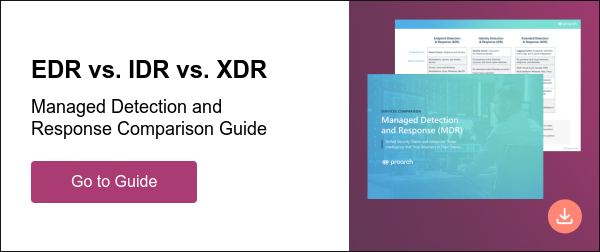Extended Detection and Response (XDR)
Extended Detection and Response (XDR) goes beyond EDR and IDR to provide holistic, end-to-end threat visibility and response across the entire environment. XDR unifies telemetry, including non-traditional and custom systems to give the full picture of an attack. This data drastically speeds up the time it takes to pinpoint root cause analysis and perform investigation and response.
ProArch’s XDR offers
- 24/7 endpoint, identity, and network monitoring and detection;
- 24/7 threat containment, eradication, and remediation performed by a dedicated SOC team;
- SIEM and SOAR capabilities; and
- seamless escalation to incident response in the case of compromise.
Especially important for supporting strict compliance requirements, an XDR solution will provide all the monitoring and logging of data needed for reporting.
Breakdown of ProArch’s MDR Services:
Read more in our MDR services comparison guide.
| Endpoint Detection & Response (EDR) | Identity Detection & Response (IDR) | Extended Detection & Response (XDR) | |
| Protection For | Device Centric: Endpoints and Servers | Identity Centric: Cloud & On-Premises Identity | Logging Centric: Endpoints, Identities, Event Logs, and Custom Integrations |
| What’s Covered | Workstations, servers, and mobile devices | On-premises Active Directory accounts and cloud-native identities |
On-premises and cloud networks, endpoints, and identities |
| Servers: Linux and Windows
Workstations: Linux, Windows, MacOS Mobile Devices: iOS and Android |
On-premises Active Directory accounts
Cloud-native identities |
Multi-cloud: Azure, Google, AWS
Multi-platform: Windows, Mac, Linux, Android, iOS |
|
| Included | 24×7 endpoint monitoring and detection performed by ProArch SOC | 24×7 identity monitoring and detection performed by ProArch SOC | 24×7 endpoint, identity, and network monitoring and detection performed by ProArch SOC |
| 24×7 threat containment, eradication, and remediation performed by ProArch SOC | 24×7 threat containment, eradication, and remediation performed by ProArch SOC | 24×7 threat containment, eradication, and remediation performed by ProArch SOC | |
| SIEM: ingestion and analysis of logs from security toolset | SIEM: ingestion and analysis of logs from security toolset | SIEM: ingestion and analysis of logs from security toolset | |
| SOAR: automated incident response | SOAR: automated incident response | SOAR: automated incident response | |
| Seamless escalation to Incident Response in the event of compromise | Seamless escalation to Incident Response in the event of compromise | Seamless escalation to Incident Response in the event of compromise | |
| Toolset |
|
|
|
MDR Powered by Microsoft Security
Microsoft's security stack continues to lead the industry, including Gartner’s Magic Quadrant. As a top Microsoft partner, ProArch's MDR services are powered by Microsoft, including Microsoft Sentinel, Microsoft Defender, and Azure Log Analytics, plus tools likely already in your environment, like Azure Active Directory.
This unified approach not only maximizes your organization’s Microsoft investment but also significantly enhances data flow for better visibility into threats without the need for custom APIs.
Choosing the Right MDR Solution for Your Organization
Choosing MDR services for your organization requires consideration of your security stature and maturity, budget, and compliance needs. Before diving into a system, ask yourself a few questions:
- Do you already have an in-house team or will you use a partner?
- What is your in-house team’s current availability and bandwidth to handle more work?
- What are your compliance requirements?
- Which systems are most at risk and need protection?
With the right partner, you can identify the best solution for your organization, ensuring you not only improve your security posture but also deliver when it comes to your budget, compliance requirements, and business objectives.
If you need additional help deciding on Managed Detection and Response and cybersecurity solutions that will offer a strengthened risk posture for your enterprise and assets, reach out to ProArch today.


